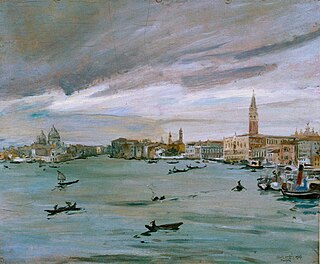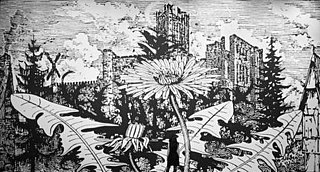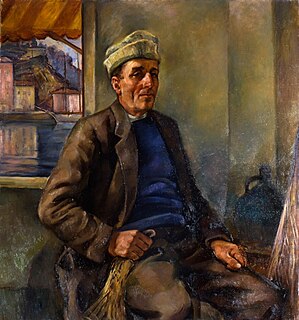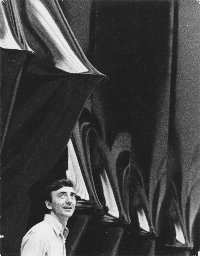Related Research Articles

Lucio Fontana was an Argentine-Italian painter, sculptor and theorist. He is mostly known as the founder of Spatialism.
Afro Libio Basaldella was an Italian painter and educator in the post-World War II period. He began as a member of the Scuola Romana, and worked together with Alberto Burri and Lucio Fontana. He was generally known by the single name, "Afro".
Giancarlo Politi is an art critic and publisher, mainly known for being the founder of Flash Art magazine.

Aldo Carpi was an Italian artist, painter and writer, author of a collection of memoirs concerning his imprisonment in the infamous Mauthausen-Gusen concentration camp.

The Ca' Pesaro is a Baroque marble palace facing the Grand Canal of Venice, Italy. Originally designed by Baldassarre Longhena in the mid-17th century, the construction was completed by Gian Antonio Gaspari in 1710. As at Longhena's Ca' Rezzonico, a double order of colossal columns and colonnettes flanking arch-headed windows, reinterpreting a motif of Jacopo Sansovino, Longhena creates the impression of double loggias extending across the main Grand Canal frontage, above a boldly rusticated basement. Today it is one of the 11 museums run by the Fondazione Musei Civici di Venezia system.

Manfredi Beninati is an Italian artist born in Palermo (Sicily) in 1970. A contemporary figurative painter, his oeuvre also covers installations, drawings, sculpture, collage and film.

Paul Morrison is a British artist. He was born in Liverpool and received a BA in fine art from Sheffield City Polytechnic. He continued his studies at Goldsmiths College of Art in London, where he received his MA. His first one-person show was in London in 1996 and since then he has exhibited extensively in museums and galleries Worldwide. Morrison lives and works in Yorkshire.

Mimmo Paladino is an Italian sculptor, painter and printmaker. He is a leading name in the Transvanguardia artistic movement and one of the many European artists to revive Expressionism in the 1980s.

108 is an Italian artist in the field of street art and contemporary art from Alessandria.

Michele Cascella was an Italian artist. Primarily known for his oil paintings and watercolours, he also worked in ceramics, lithography, and textiles. He exhibited regularly at the Venice Biennale from 1924 until 1942, and his works are owned by major museums in Italy and Europe, including Victoria and Albert Museum in London, Galerie nationale du Jeu de Paume in Paris, and Galleria Nazionale d'Arte Moderna in Rome.

Eugenio Da Venezia was an Italian painter. He was a member of the group known as I Giovani di Palazzo Carminati. This group rejected the prevailing style of the Italian Academy at the beginning of the 20th century. Da Venezia painted in a post-impressionist style, influenced by the Venetian tradition of the vedutisti. He exhibited in ten editions of Venice Biennale between 1934 and 1956, including the XL anniversary in 1935.

Alterazioni Video is an artist collective founded in 2004 in Milan, Italy and is now based in New York and Berlin. The members of the group are Paololuca Barbieri Marchi, Alberto Caffarelli, Matteo Erenbourg, Andrea Masu and Giacomo Porfiri.

Enrico Fonda was an Italian painter born in Fiume.
Luca Campigotto is an Italian artist photographer and writer.
Lucio Schiavon is an Italian illustrator.

Agostino Bonalumi was an Italian painter, draughtsman and sculptor.
Arcangelo Sassolino is an Italian artist known for his sculptures that uses technology.
Albino Lucatello was a modern Italian painter.

Gianmaria Potenza is an Italian artist born in Venice living and working in Venice, Italy.

Untitled is a painting created by American artist Jean-Michel Basquiat in 1982. The artwork was sold at Christie's for $57.3 million in May 2016. At the time, that was the record for Basquiat's most expensive painting. It is currently Basquiat's third highest auction record, and fourth most expensive painting.